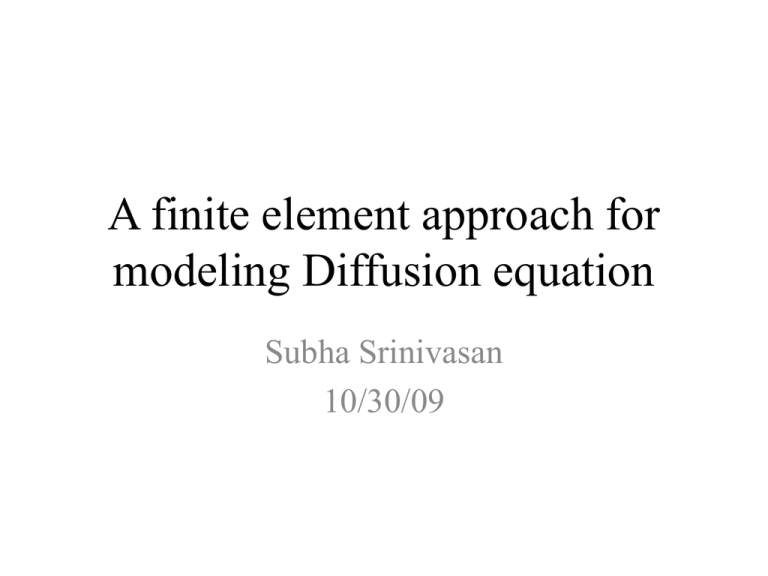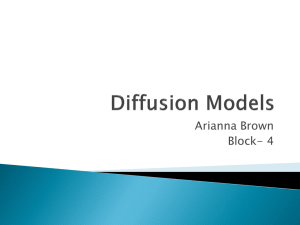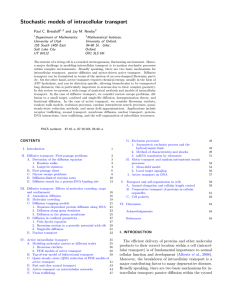A finite element approach for modeling Diffusion equation
advertisement

A finite element approach for modeling Diffusion equation Subha Srinivasan 10/30/09 Forward Problem Definition • Given a distribution of light sources qon the boundary of an object and a distribution of tissue parameters pwithin , to find the resulting measurement set M on Light Propagation in a 3-D Breast Model using BEM Light Propagation in a 3-D Breast Model using BEM Inverse Problem Definition • Given a distribution of light sources qand a distribution of measurements M on the boundary , to derive the distribution of tissue parameters p within Diffusion equation in frequency domain i . (r)(r, ) a (r) (r, ) q0 (r, ) c • is the isotropic fluence, is the Diffusion coefficient, a is the absorption coefficient and q 0 is the isotropic source (r) • s ' is 1 3a (r) s '(r) the reduced scattering coefficient Solutions to Diffusion equation • Analytical solutions exist in simple geometries • Finite difference methods (FDM) use approximations for differentiation and integration. Works well for 2D problems with regular boundaries parallel to coordinate axis, cumbersome for regions with curved or irregular boundaries • Finite element methods (FEM) can be easily applied to complicated and inhomogeneous domains and boundaries. Versatile and computationally feasible (compared to Monte Carlo methods) Using FEM for Modeling • Main concept: divide a volume/area into elements and build behavior in entire area by characterizing each element (Mosaic) • Uses integral formulation to generate a set of equations • Uses continuous piecewise smooth functions for approximating unknown quantities Basis Functions For a set of basis functions, we can choose anything. For simplicity here, shown are piecewise linear “hat functions”. Our solution will be a linear combination of these functions. φ1 x1=0 φ2 φ3 x2=L/2 x3=L Derivation of FEM formulation for Diffusion Equation i . (r)(r, ) a (r) (r, ) q0 (r, ) c N • The approximate solution is: • And for flux: j j j 1 F .n$, N F Fj j j 1 • Galerkin formulation gives the weighted residual to equal zero: w R(x)dx 0 i R,w 0 • Galerkin weak form: • Green’s identity: • Substituting: i ., w a , w q0 , w c µ wds 2u,w u.w — (u.n) .w a i .n$.wds ,w q0 ,w — c Matrix form of FEM Model N i ji ds j j .i a c j ,i q0 ,w Fj — j 1 j 1 N • Discretizing parameters: • Overall: j j 1 N K L k 1 l 1 k k , a ll N L i ji ds k k j .i l l c j ,i q0 , w Fj — k 1 l 1 j 1 K • Matrix form: Abb AIb AbI b Bbb AII I 0 0 Fb Cb 0 C 0 I • For A,B detailed, refer to Paulsen et al, Med Phys, 1995 • Need to apply BCs Boundary Conditions • Type III BC, Robin type ( ) n̂.( ) 0 • α incorporates reflection at the boundary due to refractive index change A 1 , 2A 2 / (1 R0 ) 1 cos c 1 cos c (n 1)2 R0 (n 1)2 2 3 Source Modeling • Point source: contribution of source to element in which it falls • Gaussian source: modeled with known FWHM • Distributed source model: • Hybrid monte-carlo model: Monte carlo model close to source & diffusion model away from source Paulsen et al, Med Phys, 1995 Forward Model: Forward Model for Homogeneous Domain: Multiple Sources Forward Model with Inclusion Boundary Measurements Hybrid Source Model Ashley Laughney summer project, 2007 Plots near the source Ashley Laughney summer project, 2007 References • • • • Arridge et al, Med Phys, 20(2), 1993 Schweiger et al, Med Phys, 22(11), 1995 Paulsen et al, Med Phys, 22(6), 1995 Wang et al, JOSA(A), 10(8), 1993









